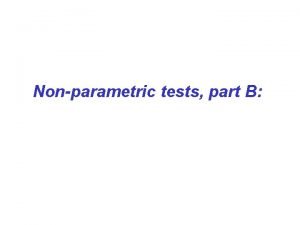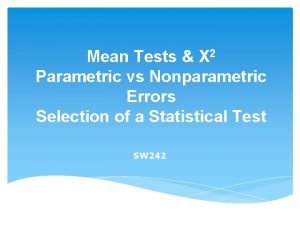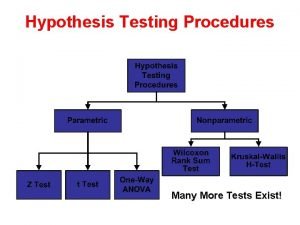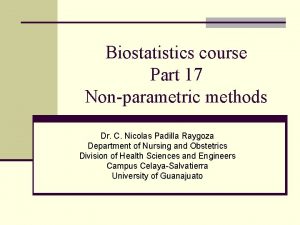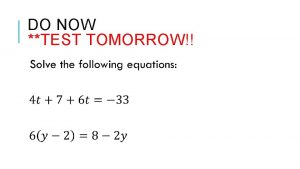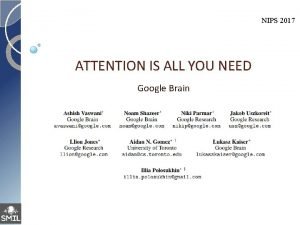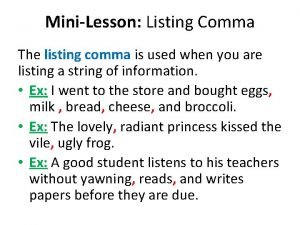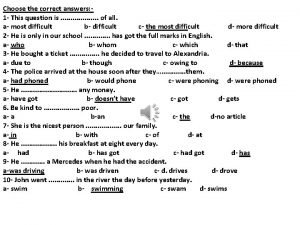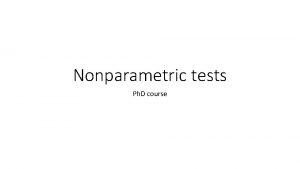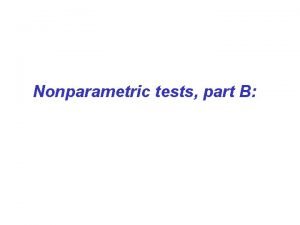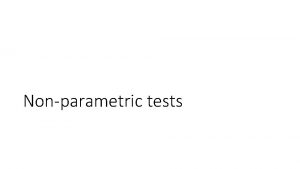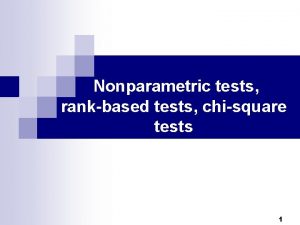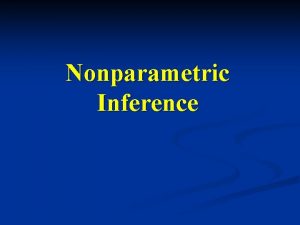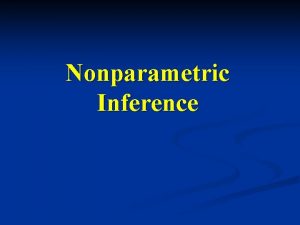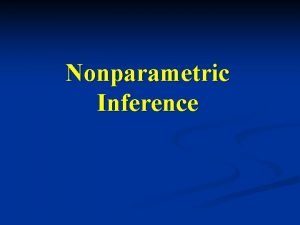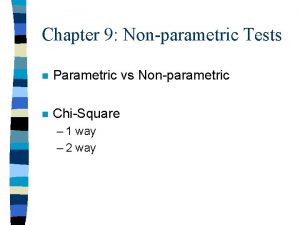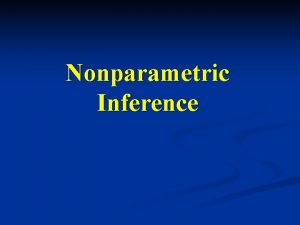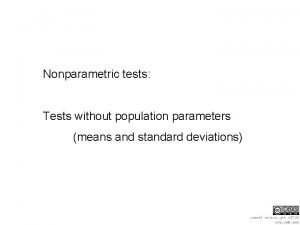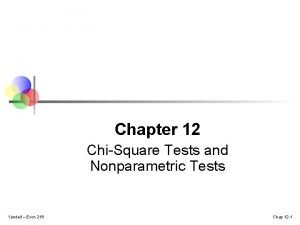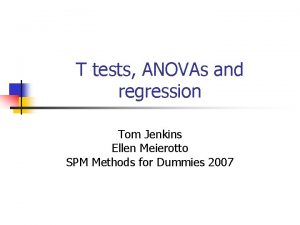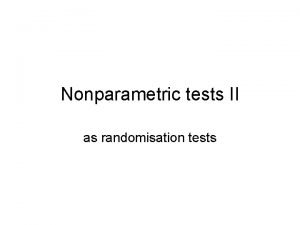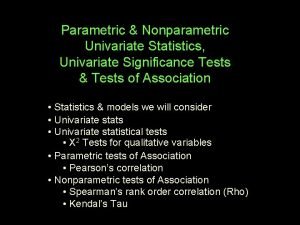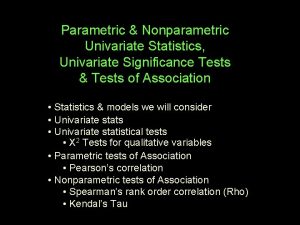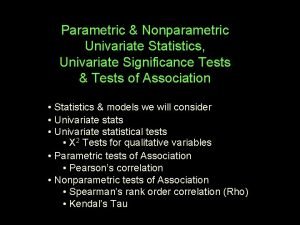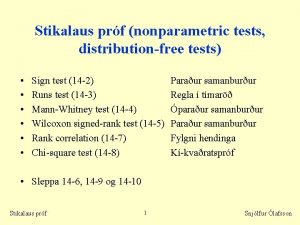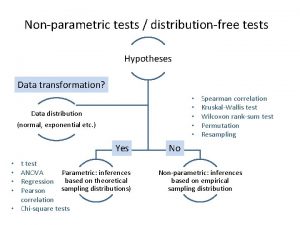Nonparametric tests and ANOVAs What you need to








































- Slides: 40

Nonparametric tests and ANOVAs: What you need to know

Nonparametric tests • Nonparametric tests are usually based on ranks • There are nonparametric versions of most parametric tests

Parametric One-sample and Paired t-test Two-sample t-test Nonparametric Sign test Mann-Whitney U-test

Quick Reference Summary: Sign Test • What is it for? A non-parametric test to compare the medians of a group to some constant • What does it assume? Random samples • Formula: Identical to a binomial test with po= 0. 5. Uses the number of subjects with values greater than and less than a hypothesized median as the test statistic. P(x) = probability of a total of x successes p = probability of success in each trial n = total number of trials P = 2 * Pr[x X]

Sign test Null hypothesis Median = mo Sample Test statistic x = number of values greater than mo compare Null distribution Binomial n, 0. 5 How unusual is this test statistic? P < 0. 05 Reject Ho P > 0. 05 Fail to reject Ho

Quick Reference Summary: Mann-Whitney U Test • What is it for? A non-parametric test to compare the central tendencies of two groups • What does it assume? Random samples • Test statistic: U • Distribution under Ho: U distribution, with sample sizes n 1 and n 2 • Formulae: n = sample size of group 1 1 n 2= sample size of group 2 R 1= sum of ranks of group 1 Use the larger of U 1 or U 2 for a two-tailed test

Mann-Whitney U test Null hypothesis The two groups Have the same median Sample Test statistic U 1 or U 2 (use the largest) compare Null distribution U with n 1, n 2 How unusual is this test statistic? P < 0. 05 Reject Ho P > 0. 05 Fail to reject Ho

Mann-Whitney U test • Large-sample approximation: Use this when n 1& n 2 are both > 10 Compare to the standard normal distribution

Mann-Whitney U Test • If you have ties: – Rank them anyway, pretending they were slightly different – Find the average of the ranks for the identical values, and give them all that rank – Carry on as if all the whole-number ranks have been used up

Example Data 14 2 5 4 2 14 18 14

Example Data 14 2 5 4 2 14 18 14 Sorted Data 2 2 4 5 14 14 14 18

Example Data 14 2 5 4 2 14 18 14 Sorted Data 2 2 4 5 14 14 14 18 TIES

Example Data 14 2 5 4 2 14 18 14 Sorted Data 2 2 4 5 14 14 14 18 TIES Rank them anyway, pretending they were slightly different

Example Data 14 2 5 4 2 14 18 14 Sorted Data 2 2 4 5 14 14 14 18 Rank A 1 2 3 4 5 6 7 8

Example Data 14 2 5 4 2 14 18 14 Sorted Data 2 2 4 5 14 14 14 18 Rank A 1 2 3 4 5 6 7 8 Find the average of the ranks for the identical values, and give them all that rank

Example Data 14 2 5 4 2 14 18 14 Sorted Data 2 2 4 5 14 14 14 18 Rank A 1 2 3 4 5 6 7 8 Average = 1. 5 Average = 6

Example Data 14 2 5 4 2 14 18 14 Sorted Data 2 2 4 5 14 14 14 18 Rank A 1 2 3 4 5 6 7 8 Rank 1. 5 3 4 6 6 6 8

Example Data 14 2 5 4 2 14 18 14 Sorted Data 2 2 4 5 14 14 14 18 Rank A 1 2 3 4 5 6 7 8 Rank 1. 5 3 4 6 6 6 8 These can now be used for the Mann-Whitney U test

Benefits and Costs of Nonparametric Tests • Main benefit: – Make fewer assumptions about your data – E. g. only assume random sample • Main cost: – Reduce statistical power – Increased chance of Type II error

When Should I Use Nonparametric Tests? • When you have reason to suspect the assumptions of your test are violated – Non-normal distribution – No transformation makes the distribution normal – Different variances for two groups

Quick Reference Summary: ANOVA (analysis of variance) • What is it for? Testing the difference among k means simultaneously • What does it assume? The variable is normally distributed with equal standard deviations (and variances) in all k populations; each sample is a random sample • Test statistic: F • Distribution under Ho: F distribution with k-1 and N-k degrees of freedom

Quick Reference Summary: ANOVA (analysis of variance) • Formulae: = mean of group i = overall mean ni = size of sample i N = total sample size

ANOVA k Samples Test statistic compare Null hypothesis All groups have the same mean Null distribution F with k-1, N-k df How unusual is this test statistic? P < 0. 05 Reject Ho P > 0. 05 Fail to reject Ho

Quick Reference Summary: ANOVA (analysis of variance) • Formulae: There a LOT of equations here, and this is the simplest possible ANOVA = mean of group i = overall mean ni = size of sample i N = total sample size


dfgroup = k-1 dferror = N-k

Sum of Squares df dfgroup = k-1 dferror = N-k Mean Squares F-ratio

ANOVA Tables Source of variation Treatment Error Total Sum of squares df Mean Squares F ratio P

ANOVA Tables Source of variation Treatment Error Total Sum of squares df Mean Squares F ratio P

ANOVA Tables Source of variation Sum of squares df Treatment k-1 Error N-k Total N-1 Mean Squares F ratio P

ANOVA Tables Source of variation Sum of squares df Treatment k-1 Error N-k Total N-1 Mean Squares F ratio P

ANOVA Tables Source of variation Sum of squares df Treatment k-1 Error N-k Total N-1 Mean Squares F ratio P

ANOVA Tables Source of variation Sum of squares df Treatment k-1 Error N-k Total N-1 Mean Squares F ratio P *

ANOVA Table: Example Source of variation Sum of squares df Treatment 7. 22 2 Error 9. 41 19 Total Mean Squares F ratio P

ANOVA Table: Example Source of variation Sum of squares df Mean Squares F ratio P Treatment 7. 22 2 3. 61 7. 29 0. 004 Error 9. 42 19 0. 50 Total 16. 64 21

Additions to ANOVA • R 2 value: how much variance is explained? • Comparisons of groups: planned and unplanned • Fixed vs. random effects • Repeatability

Two-Factor ANOVA • Often we manipulate more than one thing at a time • Multiple categorical explanitory variables • Example: sex and nationality

Two-factor ANOVA • Don’t worry about the equations for this • Use an ANOVA table

Two-factor ANOVA • 1. 2. 3. Testing three things: Means don’t differ among treatment 1 Means don’t differ among treatment 2 There is no interaction between the two treatments

Two-factor ANOVA Table Source of variation Sum of Squares df Mean Square F ratio Treatment 1 SS 1 k 1 - 1 MSE Treatment 2 SS 2 k 2 - 1 MS 2 MSE Treatment 1 * Treatment 2 SS 1*2 (k 1 - 1)*(k 2 - 1) SS 1*2 MS 1*2 (k 1 - 1)*(k 2 - 1) MSE Error SSerror XXX Total SStotal N-1 SSerror XXX P
 Parametric and non parametric test
Parametric and non parametric test Types of statistics
Types of statistics Nonparametric test
Nonparametric test Parametric vs nonparametric test
Parametric vs nonparametric test Mann-whitney u test vs t-test
Mann-whitney u test vs t-test Nonparametric methods
Nonparametric methods Parametric nonparametric 차이
Parametric nonparametric 차이 Ace different tests help iq tests
Ace different tests help iq tests I wish you strenght
I wish you strenght Examples of inverted commas
Examples of inverted commas You have three long tests tomorrow
You have three long tests tomorrow All i need is the air that i breathe and to love you abba
All i need is the air that i breathe and to love you abba Tell me what you eat and i shall tell you what you are
Tell me what you eat and i shall tell you what you are You need a passport to cross the
You need a passport to cross the Hobbies outside of school
Hobbies outside of school You only need to be lucky once
You only need to be lucky once Encoder and decoder applications
Encoder and decoder applications Why the oxford comma is important
Why the oxford comma is important Love is not all imagery
Love is not all imagery Coherence examples
Coherence examples How to make a counterclaim in an argumentative essay
How to make a counterclaim in an argumentative essay Signature on passport
Signature on passport Do you need a hook for an argumentative essay
Do you need a hook for an argumentative essay Everything you need to know about the odyssey
Everything you need to know about the odyssey Where do you need high friction when climbing
Where do you need high friction when climbing Cross traffic is eliminated on controlled access expressway
Cross traffic is eliminated on controlled access expressway Choose the correct answer (questions)
Choose the correct answer (questions) Good friend movie
Good friend movie You need to make at least 150 sandwiches for a picnic
You need to make at least 150 sandwiches for a picnic Much do you need health
Much do you need health Hebrews 10:36 sermon
Hebrews 10:36 sermon I need you lord jesus
I need you lord jesus This or that tag
This or that tag Money is all you need
Money is all you need Lindell cooley i need you more
Lindell cooley i need you more Do you love rain
Do you love rain Eat meals that are nutritious agree or disagree
Eat meals that are nutritious agree or disagree If you think you can you can poem
If you think you can you can poem I will follow wherever you may go
I will follow wherever you may go Shrek ordinary world
Shrek ordinary world Open assess
Open assess


